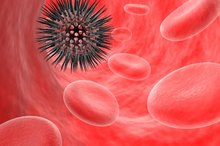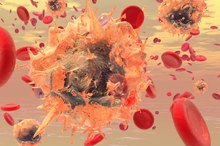What does fact checked mean?
At Healthfully, we strive to deliver objective content that is accurate and up-to-date. Our team periodically reviews articles in order to ensure content quality. The sources cited below consist of evidence from peer-reviewed journals, prominent medical organizations, academic associations, and government data.
The information contained on this site is for informational purposes only, and should not be used as a substitute for the advice of a professional health care provider. Please check with the appropriate physician regarding health questions and concerns. Although we strive to deliver accurate and up-to-date information, no guarantee to that effect is made.
What Is a Shift to the Left in Blood Testing?
A complete blood count includes tests of red blood cells (RBCs), platelets, and white blood cells (WBCs). The white blood cell count tells the total number of white cells in a sample of blood, and the differential tells the percentage of each type of white blood cell 1. By convention (since before computer printouts), laboratories reported the WBC and differential in the same order (from left to right): WBC total, bands (immature neutrophils), neutrophils, eosinophils, basophils, lymphocytes, and monocytes. This is the basis for a "shift to the left."
If you are experiencing serious medical symptoms, seek emergency treatment immediately.
Calculations
The total percentages of the differential (the percentage amount of each type of cell) must add up to 100%. You can calculate the actual number of each type of white blood cell based on its percentage.
The Shift
How to Calculate a Left Shift
Learn More
This then constitutes the "shift to the left."
White Blood Cells
White blood cells vary in number because they are part of the immune system of the body. Some remain dormant in the spleen and other lymph tissue until they are activated as part of the defense system of the body, increasing the number. Additionally, infection stimulates the bone marrow to produce more white blood cells. While normal values range from 5000 to 10,000 in most people, an acute infection (such as appendicitis) can increase this number to 15,000 or higher. (A very high count may also indicate leukemia.)
- White blood cells vary in number because they are part of the immune system of the body.
- Some remain dormant in the spleen and other lymph tissue until they are activated as part of the defense system of the body, increasing the number.
Bands and Neutrophils
A High Number of Leukocytes
Learn More
Bands are immature neutrophils, also sometimes called "stabs," which is German for "rods." According to Davis's Comprehensive Handbook of Laboratory and Diagnostic Tests, most neutrophils (also called "segs" or "polys") are mature (comprising 50 to 62% of the total white blood cell count) and the percentage of bands is low (3 to 6%). Mature neutrophils are polymorphonuclear, so the nucleus of the cell is divided (poly) and segmented. The bands, on the other hand, have not matured, so they have a band/rod shape.
- Bands are immature neutrophils, also sometimes called "stabs," which is German for "rods."
- Mature neutrophils are polymorphonuclear, so the nucleus of the cell is divided (poly) and segmented.
Infection
When infection occurs, the bone marrow starts to rapidly produce neutrophils because they are your body's main defense against bacterial infection. As large numbers of neutrophils are released into the bloodstream, increasing numbers are immature bands; so an increase in bands is the primary indicator of a shift to the left. For example, with an acute infection, the white blood cell count may increase to 15,000, the bands to 10% and the neutrophils to 65%. (The other cells will total 25%).
- When infection occurs, the bone marrow starts to rapidly produce neutrophils because they are your body's main defense against bacterial infection.
- As large numbers of neutrophils are released into the bloodstream, increasing numbers are immature bands; so an increase in bands is the primary indicator of a shift to the left.
Related Articles
References
- Medline Plus; Blood Differential
- Icahn School of Medicine at Mt. Sinai. Blood Differential Test. 2019.
- Rosado MM, Picchianti diamanti A, Cascioli S, et al. Hyper-IgM, neutropenia, mild infections and low response to polyclonal stimulation: hyper-IgM syndrome or common variable immunodeficiency? Int J Immunopathol Pharmacol. 2011;24(4):983-91. doi:10.1177/039463201102400416
- Jenne CN, Liao S, Singh B. Neutrophils: multitasking first responders of immunity and tissue homeostasis. Cell Tissue Res. 2018;371(3):395-397. doi:10.1007/s00441-018-2802-5
- Summers C, Rankin SM, Condliffe AM, Singh N, Peters AM, Chilvers ER. Neutrophil kinetics in health and disease. Trends Immunol. 2010;31(8):318-24. doi:10.1016/j.it.2010.05.006
- Manley HR, Keightley MC, Lieschke GJ. The Neutrophil Nucleus: An Important Influence on Neutrophil Migration and Function. Front Immunol. 2018;9:2867. doi:10.3389/fimmu.2018.02867
- Lima SS, França MS, Godoi CC, et al. Neutropenic patients and their infectious complications at a University Hospital. Rev Bras Hematol Hemoter. 2013;35(1):18-22. doi:10.5581/1516-8484.20130009
- Lawrence SM, Corriden R, Nizet V. The Ontogeny of a Neutrophil: Mechanisms of Granulopoiesis and Homeostasis. Microbiol Mol Biol Rev. 2018;82(1). doi:10.1128/MMBR.00057-17
- Gibson C, Berliner N. How we evaluate and treat neutropenia in adults. Blood. 2014;124(8):1251-8. doi:10.1182/blood-2014-02-482612
- De kouchkovsky I, Abdul-hay M. 'Acute myeloid leukemia: a comprehensive review and 2016 update'. Blood Cancer J. 2016;6(7):e441. doi:10.1038/bcj.2016.50
- Nishitani N, Sakakibara H. Association of psychological stress response of fatigue with white blood cell count in male daytime workers. Ind Health. 2014;52(6):531-4. doi:10.2486/indhealth.2013-0045
- Farsalinos KE, Romagna G. Chronic idiopathic neutrophilia in a smoker, relieved after smoking cessation with the use of electronic cigarette: a case report. Clin Med Insights Case Rep. 2013;6:15-21. doi:10.4137/CCRep.S11175
- Kumar CC. Genetic abnormalities and challenges in the treatment of acute myeloid leukemia. Genes Cancer. 2011;2(2):95-107. doi:10.1177/1947601911408076
- Lustberg MB. Management of neutropenia in cancer patients. Clin Adv Hematol Oncol. 2012;10(12):825-6.
- Toma A, Fenaux P, Dreyfus F, Cordonnier C. Infections in myelodysplastic syndromes. Haematologica. 2012;97(10):1459-70. doi:10.3324/haematol.2012.063420
- Wangdi T, Winter SE, Bäumler AJ. Typhoid fever: "you can't hit what you can't see". Gut Microbes. 2012;3(2):88-92. doi:10.4161/gmic.18602
- Fainsod-levi T, Gershkovitz M, Völs S, et al. Hyperglycemia Impairs Neutrophil Mobilization Leading to Enhanced Metastatic Seeding. Cell Rep. 2017;21(9):2384-2392. doi:10.1016/j.celrep.2017.11.010
- Adewoyin AS, Nwogoh B. Peripheral blood film - a review. Ann Ib Postgrad Med. 2014;12(2):71-9.
- Kyritsi EM, Yiakoumis X, Pangalis GA, et al. High Frequency of Thyroid Disorders in Patients Presenting With Neutropenia to an Outpatient Hematology Clinic STROBE-Compliant Article. Medicine (Baltimore). 2015;94(23):e886. doi:10.1097/MD.0000000000000886
- Amulic,B, Cazalet C, Haye G, et al. Neutrophil Function: From Mechanisms to Disease. Annual Review of Immunology. 2012. 30:459-489. doi:10.1146/annurev-immunol-020711-074942
Writer Bio
Wanda Lockwood has an R.N., a B.A. in humanities, and M.A.s in TESOL from Monterey Institute of International studies and humanities from California State University, Dominguez Hills. She has worked as a medical writer for six years, writing more than 100 continuing education courses for nurses and writing and editing medical study materials.







